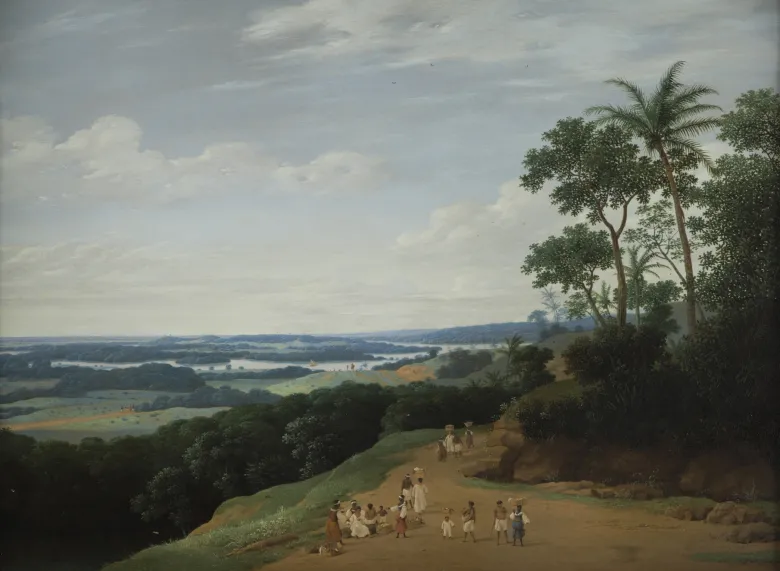The National Maritime Museum recognizes that as a museum, we can and must commit ourselves more actively to combating (institutional) racism; as an institution, in our collection, in our programming, together with our audience and with our current and future social partners. Read the answers to five frequently asked questions here.
How does the National Maritime Museum deal with the presentation of the Netherlands' colonial past and the history of slavery?
The subjects have been our focus for some time already. In our programming, the topics of colonialism and slave trade always play a key role in the stories, as an integrated part of the whole.
In 2001, The National Maritime Museum presented the exhibition Slaves and Ships and an eponymous publication. A Dark Chapter (2013) an exhibition based on research by Leo Balai, was about the slave ship Leusden, which sank on the Maroni river in Suriname at the humiliating cost of over 700 enslaved Africans. In 2019, the museum and the Evangelical Broadcasting Association created the interactive web documentary Chained, which introduces the viewer to the shared history of the Netherlands and Suriname during the time of slavery. The objects on display in the Republic at Sea exhibition provide room for new, historical perspectives. These objects place an oft told history in a broader context, which also highlights the downside of economic prosperity and cultural wealth. The exhibition also includes a porcelain figure, a famille noire, manillas and blue beads. In the See you in the 'golden age' exhibition (on display until July 5, 2020) we highlight the role of the Dutch in the 17th century: the so-called ‘golden age’. Part of the exhibition is dedicated to the history of slavery through the story of the girl Amimba, the ship model of slave ship D' Keulse Galy and a view of Dutch Brazil painted by Frans Post.
The exhibition ms Oranje | Changing Course (2017-2018) about the eventful history of the ship Oranje, amongst others told the personal story of ten people who traveled with the ship Oranje from the Dutch East Indies to the Netherlands. Between 1945 and 1965, an estimated 300,000 inhabitants of the Dutch Indies as "returnees" concluded this crossing, which many of them experienced as a journey to a distant and foreign country.
The education department has developed several programmes for education in which identity and slave-trading history play an important role. The Unfree Stories programme is about people from both then and now. How is it that people look at our slave-trading history in different ways, and how can we ensure that stories are always passed on to future generations? For secondary school students in particular, questions about identity and how others see them is important. This is a good reason for us to develop the Salt DNA programme. In a safe environment and in an open way, students can use our collection to discover who they are.

Brazilian landscape
Frans Post (1612-1680)
Haarlem, circa 1650
oil on panel
Frans Post travelled in the entourage of Johan Maurits of Nassau-Siegen, governor of Dutch Brazil. The Dutch West India Company had recently wrested control over the north-eastern part of Brazil from Portugal. The painting presents an Arcadian landscape with palm trees and a sailing boat on the river, but does not show the 25,000 enslaved Africans working for the company on the sugarcane plantations.
How does the museum address the terms 'golden age' and 'slave'?
Since 2019, the National Maritime Museum has been using the term 'golden age' without capital letters and in quotation marks. The museum uses the term sparingly and will speak of ‘the 17th century’ where this is sufficient. Despite being the case for other museums, the National Maritime Museum has decided not to abolish the term entirely. In this way, we can continue to engage in a dialogue about why this 19th century term is so controversial. As a reference point, the National Maritime Museum uses the terminology from the publication Words Matter. For example, we have also decided not to use the word 'slave' but instead 'enslaved'.
What is the story behind the VOC Ship Amsterdam?
The ship at the jetty is a replica of an East India Company (in Dutch: VOC) ship that was wrecked on its maiden voyage off the South English coast in 1749. In the 17th and 18th centuries, East Indians sailed with goods between Asia and Europe. The journey lasted approximately eight months. East Indian sailors completed nearly 5,000 journeys in two centuries. The Amsterdam was not used for the transportation of enslaved people, but for the transportation of goods like spices, porcelain, tea, silk and textiles.
What was the role of the Zeemagazijn, the building in which the current museum is located?
The National Maritime Museum is located in 's Lands Zeemagazijn. This monumental building from 1656 was designed by Daniel Stalpaert as a warehouse for the Admiralty of Amsterdam. The Zeemagazijn served as a storage space where everything from carpentry tools to nails, cannons, sails, flags and ship equipment for the war fleet were stored. Moreover, about 40,000 litres of rainwater was collected in the barrel vaults under the courtyard for the drinking water supply of the ships.
Although the Zeemagazijn had no direct relationship with the East India Company, the company was located nearby. For example, the East India Company shipyards and large warehouse (which was also referred to as the East India Sea Zeemagazijn, which may be part of the reason for potential confusion) were located at Oostenburg. VOC warehouses can also been seen on the Peperstraat, diagonally opposite to the museum. A little further away is the former office and warehouse of the West India Company at 's Gravenhekje.
How are The National Maritime Museum's views on racism safeguarded in museum policy?
The National Maritime Museum strives with its workforce to reflect Dutch society and takes this into account when recruiting staff.